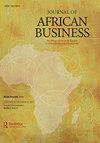金融普惠的决定因素:肯尼亚和埃塞俄比亚的比较研究
IF 1.8
Q3 BUSINESS
引用次数: 17
摘要
摘要本研究从宏观和微观两个层面对肯尼亚和埃塞俄比亚影响金融包容性的因素进行了比较分析。使用2017年全球Findex数据库,使用广义线性模型来检验金融包容性的决定因素和障碍,而使用描述性分析来探索它们的宏观层面差异。肯尼亚的金融包容性水平高于埃塞俄比亚。金融自由化政策、国内生产总值、农村人口比例和移动货币服务扩张的差异是解释这种差异的一些宏观层面的差异。识字率和政府转移支付等支付方式的差异解释了两国之间微观层面的一些差异。此外,性别、年龄、就业状况和拥有手机对金融包容性有着显著而积极的影响。然而,缺乏文件、缺乏信任和缺乏资金是金融包容性的重大障碍。本文章由计算机程序翻译,如有差异,请以英文原文为准。
Determinants of Financial Inclusion: A Comparative Study of Kenya and Ethiopia
ABSTRACT This study conducts a comparative analysis of the factors affecting financial inclusion in Kenya and Ethiopia at macro and micro levels. A generalized linear model is used to examine the determinants of and barriers to financial inclusion using the 2017 Global Findex Database, whereas a descriptive analysis is used to explore their macro-level differences. Kenya has a higher level of financial inclusion than Ethiopia. Differences in financial liberalization policy, gross domestic product, percentage of rural population, and mobile money service expansion are some macro-level differences that explain this variation. Differences in literacy rates and means of receiving payments such as government transfers explain some of the micro-level variations between the two countries. In addition, gender, age, employment status, and owning a mobile phone have significant and positive effects on financial inclusion. However, lack of documentation, lack of trust, and lack of money are significant barriers to financial inclusion.
求助全文
通过发布文献求助,成功后即可免费获取论文全文。
去求助
来源期刊

Journal of African Business
BUSINESS-
CiteScore
4.60
自引率
10.50%
发文量
36
期刊介绍:
Journal of African Business is the official journal of the Academy of African Business and Development, the largest network of professionals committed to advancement of business development in African nations. JAB strives to comprehensively cover all business disciplines by publishing high quality analytical, conceptual, and empirical articles that demonstrate a substantial contribution to the broad domain of African business. Regardless of the research context, tradition, approach, or philosophy, manuscripts submitted to JAB must demonstrate that the topics investigated are important to the understanding of business practices and the advancement of business knowledge in or with Africa. Particularly, JAB welcomes qualitative and quantitative research papers. JAB is not, however, limited to African-based empirical studies. It searches for various contributions, including those based on countries outside Africa that address issues relevant to African business. Targeted toward academics, policymakers, consultants, and executives, JAB features the latest theoretical developments and cutting-edge research that challenge established beliefs and paradigms and offer alternative ways to cope with the endless change in the business world. Covered areas: Accounting; Agribusiness Management and Policy; Business Law; Economics and Development Policy; Entrepreneurship and Family Business; Finance; Global Business; Human Resource Management; Information and Communications Technology (ICT); Labor Relations; Marketing; Management Information Systems (MIS); Non-Profit Management; Operations and Supply Chain Management; Organizational Behavior and Theory; Organizational Development; Service Management; Small Business Management; Social Responsibility and Ethics; Strategic Management Policy; Technology and Innovation Management; Tourism and Hospitality Management; Transportation and Logistics
 求助内容:
求助内容: 应助结果提醒方式:
应助结果提醒方式:


